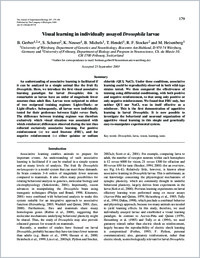Visual learning in individually assayed Drosophila larvae
Université de Fribourg
- Gerber, Bertram Department of Genetics and Neurobiology, Biocentre Am Hubland, University of Würzburg, Germany - Department of Biology and Program in Neuroscience, University of Fribourg, Switzerland
- Scherer, Sabine Department of Biology and Program in Neuroscience, University of Fribourg, Switzerland
- Neuser, K. Department of Genetics and Neurobiology, Biocentre Am Hubland, University of Würzburg, Germany
- Michels, B. Department of Genetics and Neurobiology, Biocentre Am Hubland, University of Würzburg, Germany
- Hendel, T. Department of Genetics and Neurobiology, Biocentre Am Hubland, University of Würzburg, Germany
- Stocker, Reinhard F. Department of Biology and Program in Neuroscience, University of Fribourg, Switzerland
- Heisenberg, M. Department of Genetics and Neurobiology, Biocentre Am Hubland, University of Würzburg, Germany
-
2004
Published in:
- Journal of Experimental Biology. - 2004, vol. 207, no. 1, p. 179-188
English
An understanding of associative learning is facilitated if it can be analyzed in a simple animal like the fruit fly Drosophila. Here, we introduce the first visual associative learning paradigm for larval Drosophila; this is remarkable as larvae have an order of magnitude fewer neurons than adult flies. Larvae were subjected to either of two reciprocal training regimes: Light+/Dark- or Light-/Dark+. Subsequently, all larvae were individually tested for their preference between Light versus Dark. The difference between training regimes was therefore exclusively which visual situation was associated with which reinforcer; differences observed during the test thus reflected exclusively associative learning. For positive reinforcement (+) we used fructose (FRU), and for negative reinforcement (-) either quinine or sodium chloride (QUI, NaCl). Under these conditions, associative learning could be reproducibly observed in both wild-type strains tested. We then compared the effectiveness of training using differential conditioning, with both positive and negative reinforcement, to that using only positive or only negative reinforcement. We found that FRU only, but neither QUI nor NaCl, was in itself effective as a reinforcer. This is the first demonstration of appetitive learning in larval Drosophila. It is now possible to investigate the behavioral and neuronal organization of appetitive visual learning in this simple and genetically easy-to-manipulate experimental system.
- Faculty
- Faculté des sciences et de médecine
- Department
- Département de Biologie
- Language
-
- English
- Classification
- Biological sciences
- License
-
License undefined
- Identifiers
-
- RERO DOC 4146
- DOI 10.1242/jeb.00718
- Persistent URL
- https://folia.unifr.ch/global/documents/299604
Statistics
Document views: 319
File downloads:
- Texte intégral: 333
